Lake Superior Steelhead
Our Lake Superior Steelhead are of the same family of fish as the Pacific Coast Steelhead (Oncorhynchus mykiss); the names simply categorize the fish by the lifestyle. The name, rainbow trout, most likely derived from the pinkish stripe on both lateral sides, refers to a non-migratory fish which never leaves its home waters. Lake Superior steelhead on the other hand are potamodromous. They are born in upstream freshwater, then migrate downstream to Lake Superior as juveniles to grow into adults before migrating back upstream to spawn. This cycle occurs entirely in fresh water. The basic distinction – steelhead migrate and rainbow trout don’t.
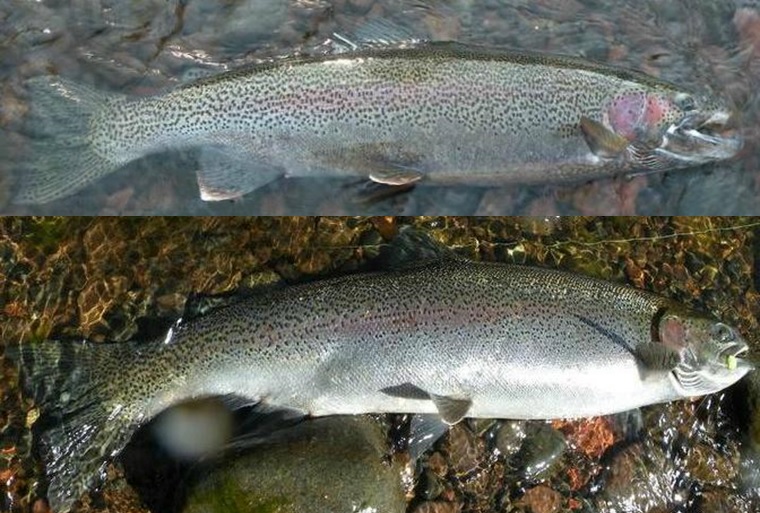
The Lake Superior steelhead of today have ancestral roots from the Pacific Coast Rivers. The first of our transplanted steelhead came to the Canadian waters of Lake Superior in 1883. Than have since naturalized themselves.
Later introductions were made in 1885 in the St. Louis River and in 1901 in the ever popular Lester River and Poplar River. It didn’t take long for anglers to realize the remarkable success of these fish. Though suffering in the early days, like the lake trout, of near catastrophic depredation from the Sea Lamprey, our Steelhead, with the help of lamprey control and continued stocking, continues today to arguably be the most sought after fish on the North Shore.
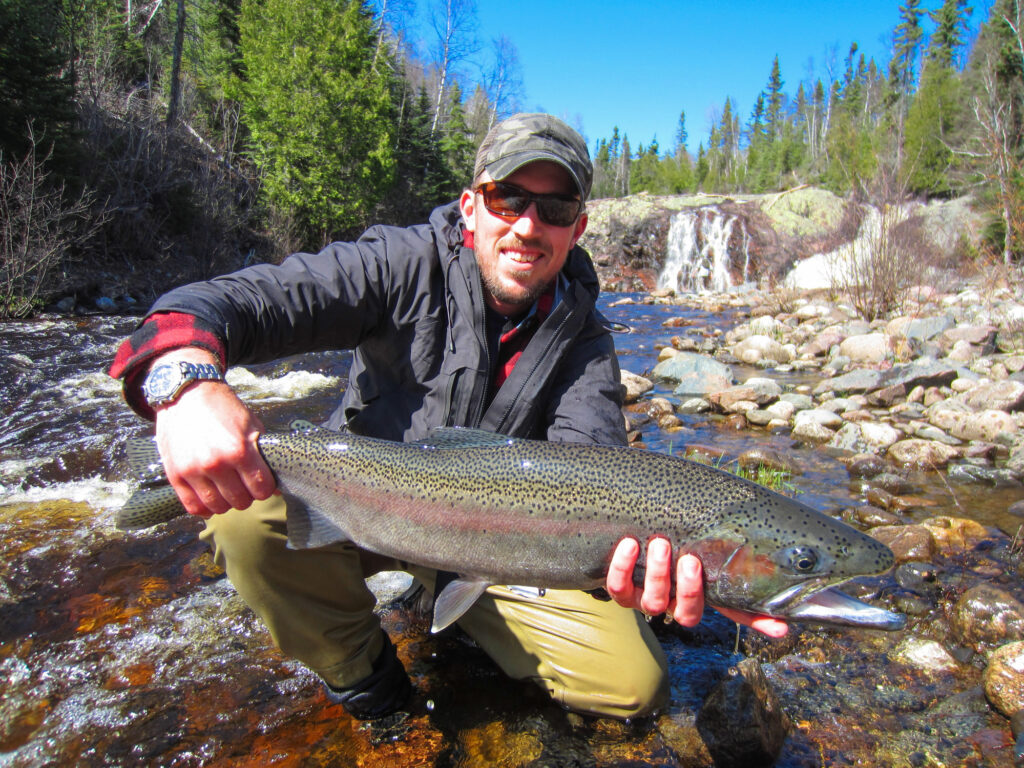
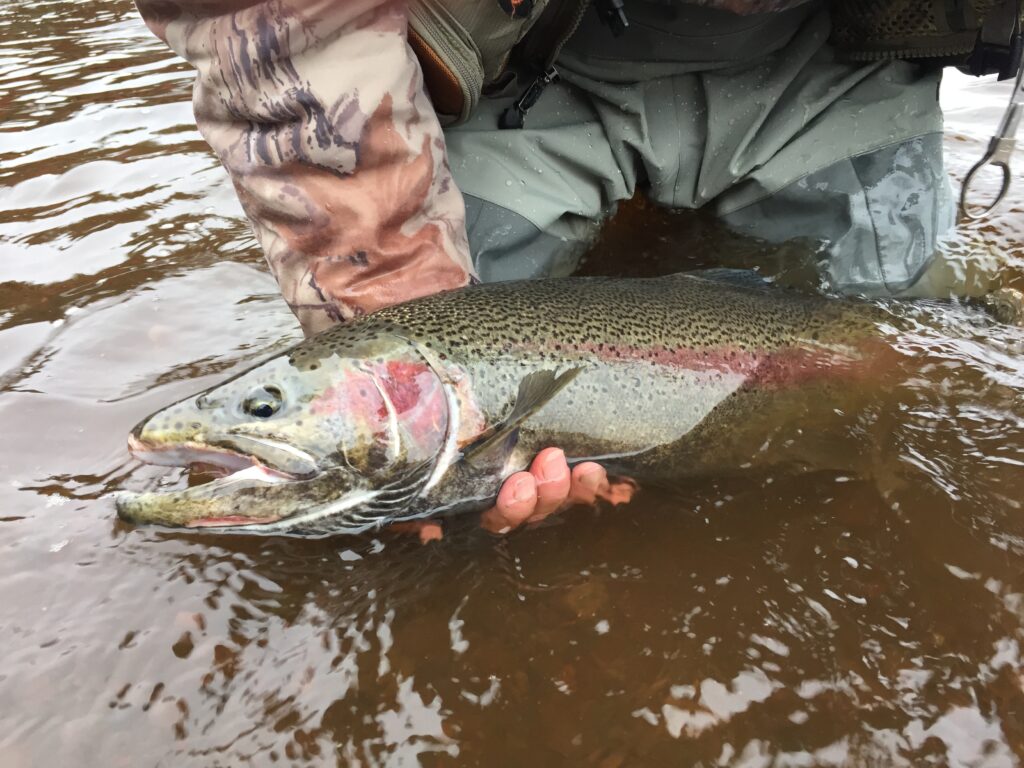

Today our steelhead have approximately 60 streams and rivers along Minnesota’s North Shore accessible for their spring migration; roughly 20 of these waters produce major spring runs. One can pursue these silver bullets as soon as the rivers open up from the ice cover, usually in April. At this time as the water warms, steelhead are quick to ascend the rivers (in most cases less than a mile), dig their redds, spawn, and return to the big lake in hopes to spawn another season.
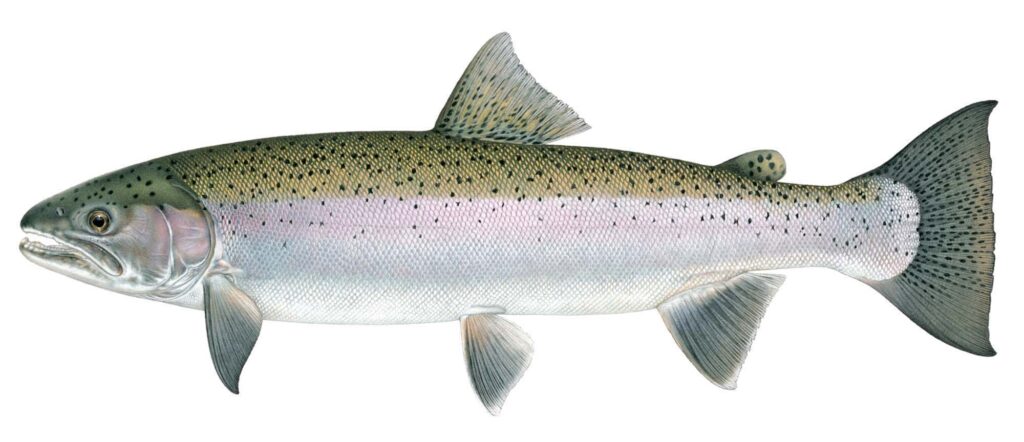
The Steelhead of the North Shore have nearly 145 miles of rivers to run. 80 of these miles are accessible through the modification of natural falls and barriers engineered during stream improvement projects.
Fall runs on the North Shore? It is not known for certain why it happens but, some steelhead along the North Shore will also run in the late fall of the year, usually with the onset of rain storms, rising rivers and the cold November weather. These types of conditions require a patient, determined breed of angler. Though the conditions can be tough, anyone who has tied into one of these fall beauties knows that the intense fights and spectacular leaps are second to none.
PLEASE NOTE: If you catch a tagged steelhead, leave the tag in the fish and record the number. Report the tag number, along with the date, location, and if the fish was harvested or released to Lake Superior Fisheries. Unclipped steelhead cannot be harvested, even if they have a tag. Contact the MN DNR with the data you have collected, they can provide you with information on when and where the fish was tagged including the age of the fish.
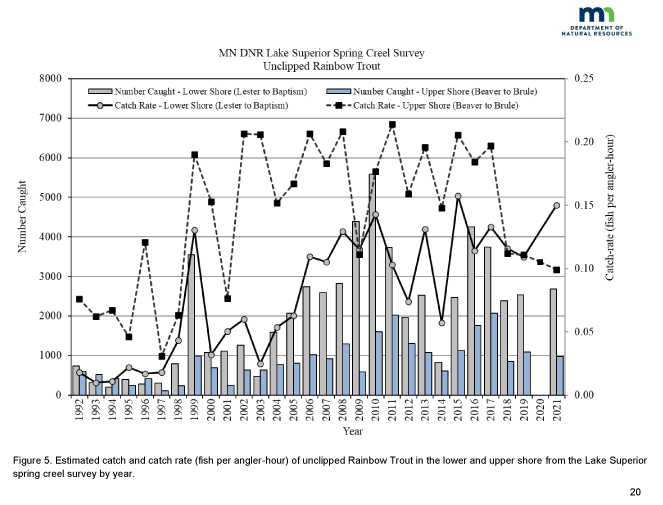
Management of Steelhead in Minnesota Waters of Lake Superior
Like non-native pheasants being introduced to Minnesota in 1916, non-native steelhead were introduced to Minnesota waters of Lake Superior in 1883 and rapidly became a popular sport fishery. Steelhead adapted well to the freshwater environment, established self-sustaining populations, and became part of the Lake Superior food web and ecosystem. In the 14 decades since their introduction, the steelhead fishery has remained a very popular sport fishery backed by a strong coalition of angling stakeholder groups (again like pheasants) and, as such, the Minnesota DNR manages them as they would any other sportfish.
Most North Shore tributaries to Lake Superior have a waterfall barrier close to the lake meaning there is only a small stretch of river available for any potamodromous (migrate from freshwater lakes to freshwater rivers to spawn) fishes to spawn. In fact, of the 16 “highest quality” North Shore tributaries excluding the Knife River there is only 19.3 river miles of habitat available for spawning below waterfall barriers – much of which is lower quality compared to cold headwater tributary habitats. The Knife River is unique in that near its mouth the Minnesota DNR operates a catch-and-sort fish trap that allows steelhead access to over 56 miles of upstream river habitat for spawning and rearing, making it by far the most important tributary for steelhead and other potamodromous fishes including native Coaster Brook Trout which have also been caught at the Knife River Trap and passed upstream.
It is the opinion of the Minnesota DNR that although steelhead may not be native to Minnesota waters of Lake Superior, they have been an established part of the food-web and ecosystem for over 142 years and must be part of the Lake Superior and tributary management strategy, especially aquatic habitat improvement projects, for what is good for steelhead will also be good for native species like Brook Trout. The MNDNR Lake Superior office is currently researching specific habitat use of Brook Trout and steelhead in the Knife and Stewart River systems to better understand the thermal preferences for each species and how much habitat overlap might exist which hopefully will provide insight into how the two species interact. Coldwater habitats on North Shore tributaries to Lake Superior are facing numerous threats including warming waters, more frequent severe storms, droughts, natural and man-made barriers to migration, and loss of riparian shade from forest pests and disease. Terrestrial and aquatic habitat improvement projects have been very important in combating these threats and will continue to be critical management strategies for all fish species into the future.
(Goldsworthy et al.)
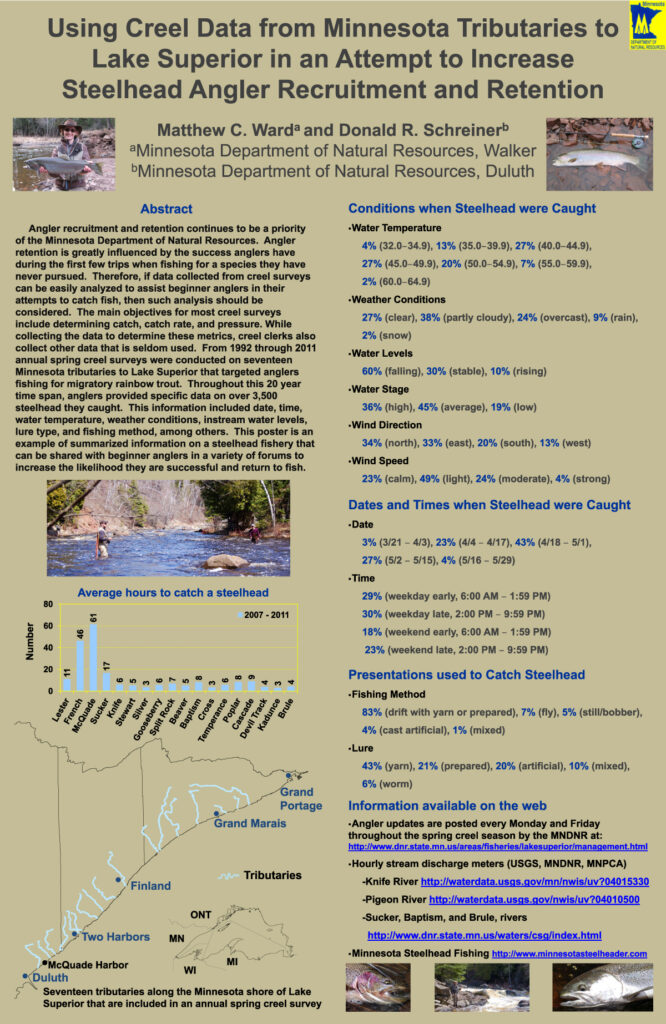
Using DNR Creel Data from Minnesota Tributaries to Lake Superior to help increase steelhead angler success.
This Steelhead Poster was created by the MN DNR several years ago as a tool steelhead anglers can use to better understand conditions, timing, and presentations. It is part of an effort to increase angler catch rates as well as draw new, and keep existing anglers engaged in steelhead fishing. It contains great information regardless of how long you’ve been steelheading, check it out!
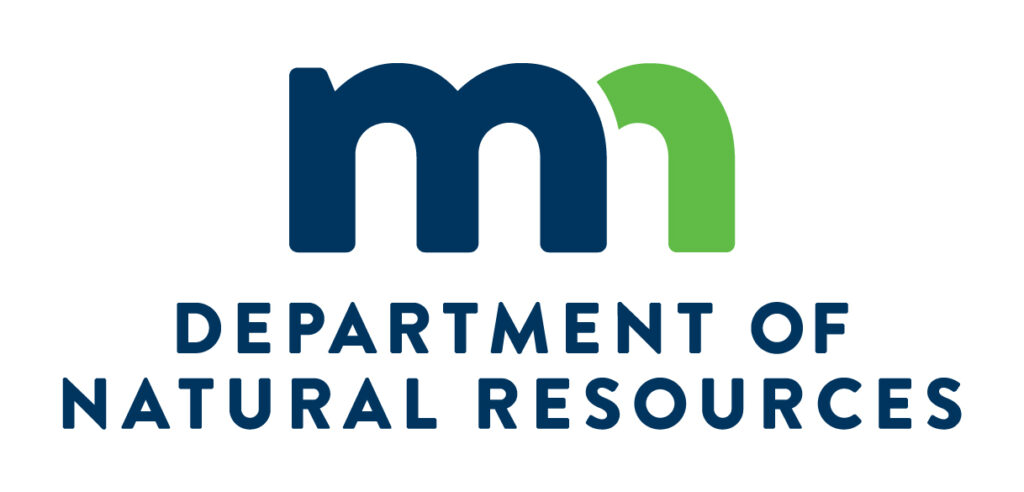
Fisheries Management Plan for Minnesota Waters of Lake Superior
This plan is a comprehensive guide on how to best manage Minnesota’s portion of the Lake Superior fishery. The plan is written for use by both the MN DNR Fisheries Management Section and citizens interested in the management of Minnesota’s Lake Superior fishery resource. This plan is based on a fish community approach to fisheries management and highlights why this approach is necessary
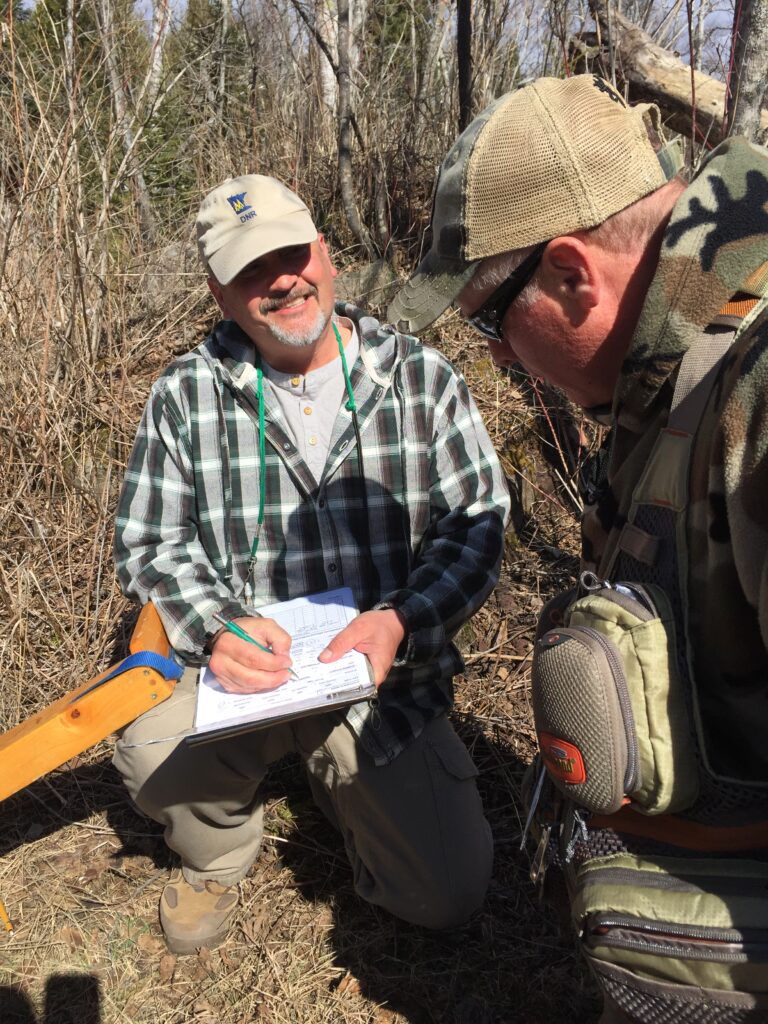
MN DNR Spring Creel Survey
The first spring creel survey was implemented in 1992 to monitor the rehabilitation of Rainbow Trout in Minnesota waters after the species declined in the 1960s. The survey was designed to target anglers who fished for Rainbow Trout as they migrated upstream in tributaries to spawn.
The annual spring creel survey typically begins once tributaries thaw and are fishable. The spring creel survey has provided useful information for many other species in Lake Superior. Brook Trout (Salvelinus fontinalis), one of two native sport fish to Lake Superior, are typically the second most reported species in the spring creel survey.
